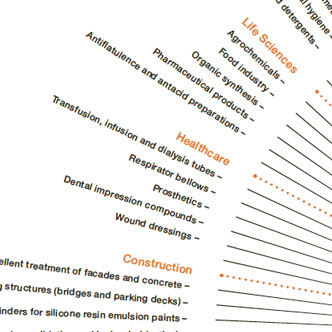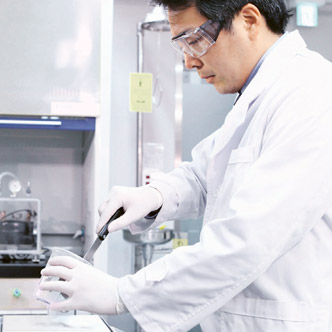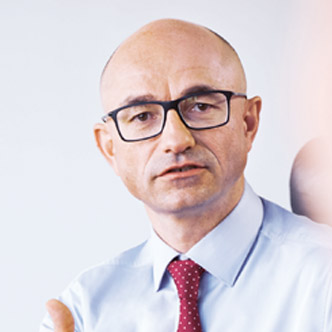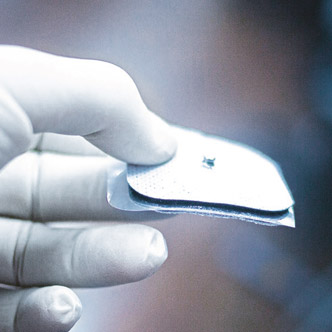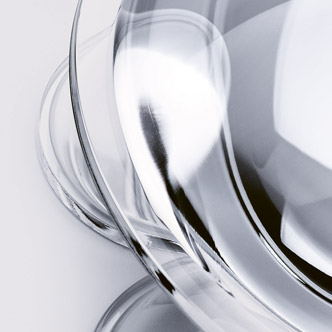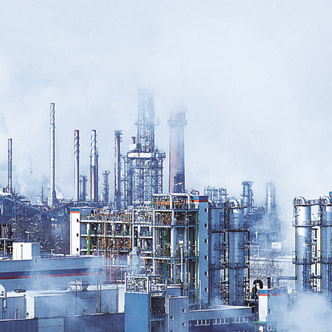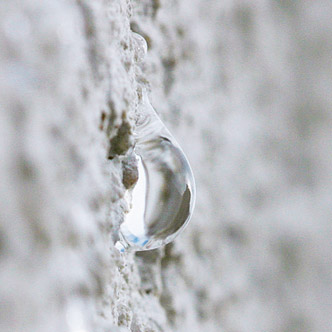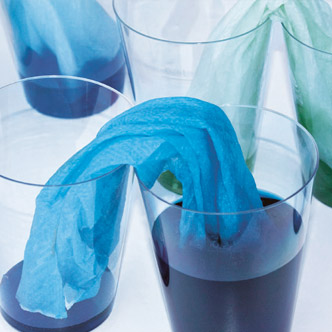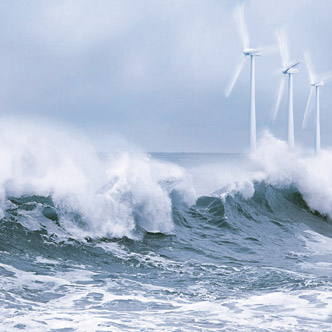Sector-Specific Conditions
We supply products to a wide range of industries. Our main customers are in the semiconductor, photovoltaic, chemical, construction, electrical and electronics sectors.
WACKER’s Chemical Divisions Report Good Sales Trend
The chemical industry expanded at a subdued pace in 2016 and chemical-product prices declined. According to the German Chemical Industry Association (VCI), global sector sales (including pharmaceuticals) totaled €4.7 trillion in 2015, with Asia accounting for just under 60 percent. The difficult international market environment also affected German chemical companies. Amid weak international demand, production had to be curbed in Germany at times. Continuing low oil prices, though, helped make German producers more competitive. The weak euro also bolstered exports. Capacity utilization at German chemical plants was 83.7 percent. According to the VCI, chemical production in Germany expanded by 0.5 percent in 2016. But with prices substantially lower, the sector’s sales declined by 3 percent versus the previous year to €183 billion (2015: €189 billion).
At WACKER, the chemical divisions lifted their sales year over year. The rise was mainly due to increased volumes in all segments, albeit with prices lower in a number of product groups. WACKER SILICONES recorded good demand for silicone products for electronics, consumer goods and plastics, as well as for medical technology. WACKER POLYMERS achieved a slight increase in sales of dispersible polymer powders and VAE dispersions. At WACKER BIOSOLUTIONS, pharmaceutical proteins performed particularly well.
Construction Industry Grows in 2016
According to market research institute B+L Marktdaten GmbH, the global construction industry grew by 2.1 percent in 2016 to US$ 8.6 trillion (2015: US$ 8.4 trillion). Construction contracts in Western Europe increased by 1.8 percent. Sales in the German construction industry reached US$ 334.4 billion in real terms (2015: US$ 325.6 billion). Eastern Europe saw a marginal decline of 0.1 percent in construction contracts, basically due to the sluggish trend in Russia’s construction sector. Investment spending in the US construction industry grew by 2.3 percent in 2016. At US$ 1.6 trillion, China remains the largest market worldwide. After experiencing weak growth in 2015, it returned to a significantly more positive trajectory in the reporting year.
Growth Rate of Construction by Region in 2016
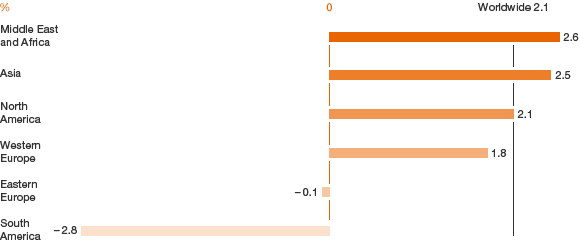
Source: B+L Marktdaten GmbH. Status: November 2016
WACKER POLYMERS posted another sales increase for construction applications. Growth in dispersible polymer powders was fueled by the market for dry-mix mortar in the USA, for example, and Southeast Asia. We also generated further sales growth in Western and Central Europe. Overall, we sold around 9,000 additional metric tons of dispersible polymer powders to the construction industry. In dispersions, WACKER POLYMERS performed strongly in the Americas. Beside adhesives and sealants, another key sector for our VAE dispersions was the market for water-based, environmentally compatible coatings. At WACKER SILICONES, construction-application sales also grew. All three product segments – building protection, sealants and adhesives, and silane-modified polymers – posted further gains. In 2016, sales climbed in Europe and Asia. Our performance was particularly strong in Southeast Asia, India and the CIS countries.
Electrical and Electronics Industries Grow in Emerging Markets
According to the German Electrical and Electronic Manufacturers’ Association (ZVEI), the global market for the electrical and electronics industries saw further growth, expanding 3 percent to about €3.7 trillion in 2016 (2015: €3.6 trillion). The main impetus came from China and emerging markets, which gained around 5 percent. In Germany, the fifth-largest market worldwide, sales advanced to some €182 billion according to the ZVEI (2015: €178 billion).
WACKER has three business divisions that supply customers in the electrical and electronics industries. Siltronic posted a slight year-over-year increase in volumes sold to semiconductor-industry customers. WACKER POLYSILICON supplied almost 10 percent of its polysilicon volumes to customers in the electronics industry in 2016. WACKER SILICONES lifted its product sales for electronics applications by 6 percent. We recorded sales growth in media-resistant potting compounds, in highly specialized silicone rubber grades and silanes for the semiconductor industry, and in silicone gels for automotive electronics. The cable and insulator business also grew, with sales rising by 11 percent.
Photovoltaics Established as a Mainstay of Global Energy Supply
In the global solar industry, all signs continued to point to growth in 2016. According to various market studies and our own estimates, some 76 gigawatts (GW) of capacity were newly installed worldwide (2015: 56 GW). That was about 36 percent more than the year before. As a result, globally installed photovoltaic capacity totaled some 300 GW at the end of 2016. Approximately 70 percent of the new capacity was installed in China, Japan and the USA in 2016. Incentives and substantially lower system costs made a major contribution to the expansion of PV installations.
Installation of New PV Capacity in 2015 and 2016
| Download XLS |
|
||||||||
|
Installation of New PV Capacity (MW) |
Growth in |
||||||
|
2016 |
2015 |
% |
|||||
|
|
|
|
|||||
|
||||||||
|
|
|
|
|||||
Germany |
1,500 |
1,500 |
– |
|||||
France |
800 |
900 |
-11 |
|||||
Italy |
400 |
300 |
33 |
|||||
Rest of Europe |
4,000 |
5,900 |
-32 |
|||||
USA |
14,600 |
7,300 |
100 |
|||||
Japan |
8,300 |
10,800 |
-23 |
|||||
China |
30,000 |
16,500 |
82 |
|||||
India |
4,200 |
2,100 |
100 |
|||||
Other regions |
12,200 |
10,900 |
12 |
|||||
Total |
76,000 |
56,200 |
35 |
|||||
|
|
|
|
|||||
Despite strong global growth in new PV installations, market conditions in this industry remained challenging, particularly in the second half of the year. Growth in PV installations was strong in the first half of the year ahead of a change in China’s feed-in tariffs that came into effect on July 1, 2016. Demand was significantly lower in the months that followed. As a result, prices declined at every stage of the supply chain. Since mid-October, though, a slight price recovery has been apparent. During the year as a whole, persistently strong price pressure nevertheless prevented companies in this industry from achieving any major improvement in their financial situation.
Growing Demand for Silicon Wafers
In 2016, demand for silicon wafers for the semiconductor industry – measured by surface area sold – was higher than the year before. The SEMI trade association estimated that, compared with 2015, global volumes by surface area sold climbed by 2.9 percent. In the first quarter, demand was rather subdued and came in below the prior-year figure. As the year progressed, though, the market clearly gained momentum, with silicon demand in the following quarters even exceeding the record levels of a year earlier.
Spot-Price Trends for WACKER’s Key Raw Materials
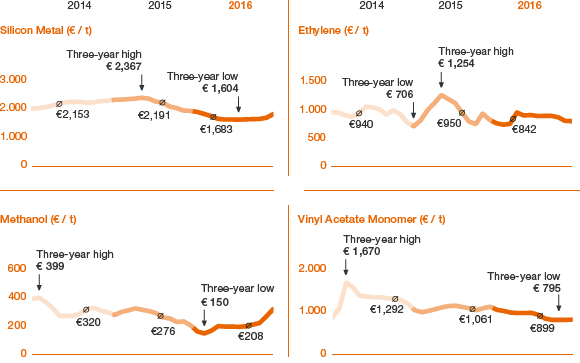
Ø Annual average in each case
Raw-Material Costs Decline Year over Year
Raw-material costs in 2016 were lower than the year before. Ethylene was slightly cheaper, while the prices for silicon metal and vinyl acetate monomer (VAM) fell by over 14 percent. The average price of methanol dropped substantially, by around 26 percent.
